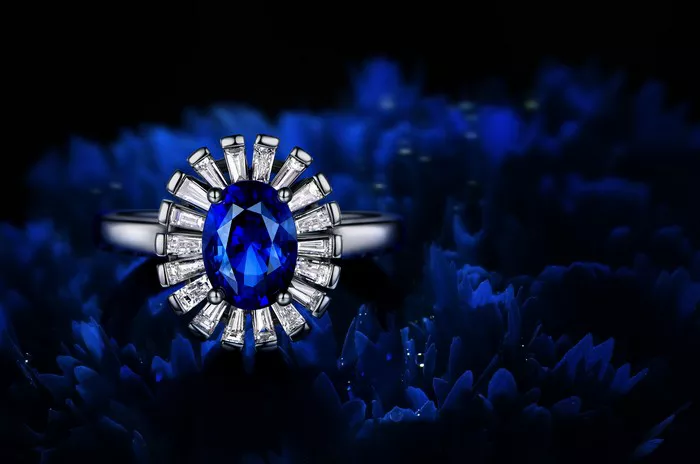Kashmir sapphires are among the most coveted gemstones in the world, renowned for their exquisite blue hue and rarity. Originating from the Kashmir region in northern India, these sapphires are prized for their unique characteristics that set them apart from sapphires found in other parts of the world. This article will guide you through the process of identifying a Kashmir sapphire, covering its distinctive features, historical background, and the scientific methods used to verify its authenticity.
Historical Background
The Discovery of Kashmir Sapphires
Kashmir sapphires were first discovered in the late 19th century in the Padar region of Kashmir. The story goes that a landslide revealed these stunning blue stones, which quickly garnered attention for their exceptional quality. Mining in this region peaked between 1882 and 1887, producing some of the finest sapphires ever seen. However, the mines were soon depleted, making Kashmir sapphires even more rare and valuable.
The Legacy of Kashmir Sapphires
Despite the short period of active mining, Kashmir sapphires left an indelible mark on the gemstone market. Their allure is such that they are often featured in high-end auctions and are highly sought after by collectors and connoisseurs. The legacy of Kashmir sapphires continues to this day, with their reputation for unparalleled beauty and rarity firmly established.
Distinctive Features of Kashmir Sapphires
Cornflower Blue Color
The most striking feature of a Kashmir sapphire is its cornflower blue color. This vibrant yet velvety blue hue is often described as “cornflower blue,” a term that has become synonymous with the finest quality sapphires. The color is evenly distributed throughout the stone, with no zoning or color banding, which can be a sign of lesser quality.
Velvety Texture
Kashmir sapphires are renowned for their velvety texture, a result of tiny inclusions known as “silk.” These inclusions are rutile needles that scatter light, giving the gemstone a soft, velvety appearance. This unique characteristic enhances the sapphire’s color and adds to its overall allure.
High Transparency
While inclusions are present, Kashmir sapphires maintain a high degree of transparency. The inclusions are often so fine that they do not detract from the stone’s clarity but rather contribute to its distinctive look. This combination of inclusions and transparency is a hallmark of genuine Kashmir sapphires.
Scientific Identification Methods
Gemological Examination
A thorough gemological examination is the first step in identifying a Kashmir sapphire. This involves using tools such as a loupe or microscope to inspect the gemstone for its characteristic features, including color, inclusions, and transparency.
Spectroscopy
Spectroscopy is a scientific method used to analyze the light spectrum of a gemstone. Kashmir sapphires exhibit specific absorption lines and bands that can help gemologists determine their origin. This non-invasive technique is essential for distinguishing Kashmir sapphires from those mined in other regions.
Inclusion Analysis
The presence and type of inclusions within a sapphire can provide significant clues about its origin. In Kashmir sapphires, the rutile silk inclusions are typically arranged in a dense, crisscross pattern. These inclusions, when examined under a microscope, help confirm the gemstone’s provenance.
Chemical Composition
Analyzing the chemical composition of a sapphire can also aid in identifying its origin. Kashmir sapphires have a unique chemical signature, with trace elements such as iron and titanium present in specific ratios. Advanced techniques like laser ablation-inductively coupled plasma-mass spectrometry (LA-ICP-MS) are used to determine these trace elements and verify the gemstone’s authenticity.
Market Considerations
Authenticity Certificates
Given the high value of Kashmir sapphires, authenticity certificates from reputable gemological laboratories are crucial. These certificates provide detailed information about the gemstone’s characteristics and confirm its origin, offering buyers peace of mind.
Pricing and Value
The rarity and exceptional quality of Kashmir sapphires make them highly valuable. Prices can vary significantly based on factors such as color, size, and clarity. A top-quality Kashmir sapphire can command prices that far exceed those of sapphires from other regions.
See Also: What is Kashmir Sapphire?
Practical Tips for Buyers
Buy from Reputable Sources
When purchasing a Kashmir sapphire, it is essential to buy from reputable dealers or auction houses. Established sources are more likely to provide authentic gemstones with proper documentation.
Request a Comprehensive Report
Always request a comprehensive gemological report from a recognized laboratory. This report should include details about the gemstone’s origin, color, clarity, and any treatments it may have undergone.
Be Wary of Treatments
Some sapphires undergo treatments to enhance their color or clarity. While treated sapphires can still be beautiful, untreated Kashmir sapphires are more valuable. Ensure that any treatments are fully disclosed and documented in the gemological report.
Conclusion
Identifying a Kashmir sapphire requires a combination of visual inspection, scientific analysis, and market knowledge. The unique characteristics of these sapphires, such as their cornflower blue color, velvety texture, and high transparency, set them apart from other gemstones. By understanding these features and employing advanced identification methods, buyers and gemologists can confidently distinguish genuine Kashmir sapphires from imitations.
Kashmir sapphires represent the pinnacle of gemstone beauty and rarity. Their legacy, forged in the remote mines of the Kashmir region, continues to captivate collectors and enthusiasts worldwide. Whether you are a seasoned gemologist or a passionate collector, the allure of Kashmir sapphires is undeniable, making them a timeless treasure in the world of gemstones.


